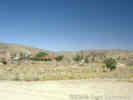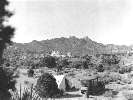 Field Notes of Annie Alexander and
Louise Kellogg
Field Notes of Annie Alexander and
Louise Kellogg 
Tom Schweich
 Field Notes of Annie Alexander and
Louise Kellogg Field Notes of Annie Alexander and
Louise Kellogg | The Eastern Mojave Desert plant collections of Annie Alexander and Louise Kellogg |

| Tom Schweich |

Topics in this Article: Literature Cited | |
|
The association of Annie Montague Alexander (1867-1950), heiress to the C&H Sugar fortune, with prominent University of California paleontologists and zoologists is well known.
|
|
Literature Cited: Locations: Humboldt Range.
After attending lectures by paleontologist John C. Merriam, Miss Alexander financed Merriam's "Saurian expedition“ to the Humboldt Range in Nevada in 1905. No mere bystander, she was also the cook! The 1905 Saurian Expedition is described at the University of California Museum of Paleontology (UCMP) web site:
Saurian Expedition of 1905. Miss Alexander's continuing association with the UC Museum of Paleontology is further described at the UCMP web site: Annie Montague Alexander: Benefactress of UCMP.
|
| Literature Cited: Following Merriam’s departure from
University of California, she formed a partnership with zoologist Joseph Grinnell, which led to her endowments of UC Museum of Vertebrate Zoology (MVZ), in addition to several other museums. Her continuing association with the Museum of Vertebrate Zoology is described in the MVZ's web site about Annie Montague Alexander. More information about the life of Annie Alexander is published in “On Her Own Terms” by Barbara R. Stein.
|
| Less well known are
the plant collections of Annie and her friend Louise Kellogg from 1939 until 1949. With the death of Joseph Grinnell in 1939, Annie and Louise turned their attention to collecting plants. There are almost 6,000 vouchers of plants collected by Annie Alexander at the University (UC) and Jepson (JEPS) Herbaria. Annie continued to collect late into her life. On her 80th birthday, she was collecting in Baja California with Anetta Carter.
|
|  Whipple Mountains as seen from Bowmans Wash near Crossroads, California
Whipple Mountains as seen from Bowmans Wash near Crossroads, California
Locations: Clark Mountain. Inyo Mountains. Kingston Range. New York Mountains. Owens Valley. Panamint Mountains. Saline Valley. Whipple Mountains. Yucca Grove. Sheep Range.
Annie and Louise collected plants in the Eastern Mojave in four separate years.
|
| Locations: Barnwell. Caruthers Canyon. Clark Mountain. Keystone Canyon. Mojave National Preserve.
In 1939 and 1940 Annie and Louise collected in what is now Mojave National Preserve. After collecting at Barnwell and Clark Mountain in 1939, they returned in 1940 to collect for 2 weeks in Caruthers Canyon, Keystone Canyon and other nearby locations.
|
|  Barnwell in June, 2000.
Barnwell in June, 2000. Locations: Barnwell. Keystone Canyon.
Barnwell was a junction on the Ivanpah Branch of the Atchison, Topeka, and Santa Fe Railroad. Many well-known collectors came to Barnwell and nearby Keystone Canyon. |
|
 Camp in Caruthers Canyon
Camp in Caruthers Canyon Locations: Caruthers Canyon. Fourth of July Canyon. Keystone Canyon. Lanfair Valley. Ledge. New York Mountains.
On May 3, 1940, Annie and Louise arrived in Lanfair Valley, expecting to collect in Keystone Canyon. However, in their words: |
|
 "Balanced Rock" in Caruthers Canyon, 2000.
"Balanced Rock" in Caruthers Canyon, 2000.  "Balanced Rock" in Caruthers Canyon, 1940.
"Balanced Rock" in Caruthers Canyon, 1940.
Other Articles: The Canyon Question: Introduction Locations: Caruthers Canyon.
Annie and Louise were really in Caruthers Canyon, and not in Fourth of July Canyon as they thought. The reasons I believe this to be true are:
|
|  Caruthers Canyon in June, 2000.
Caruthers Canyon in June, 2000.  Caruthers Canyon in May, 1940.
Caruthers Canyon in May, 1940.
Locations: Caruthers Canyon. Some of the
photographs they took have historic or comparative value. There are 9 general photographs of Caruthers Canyon, and 4 other photographs of plants collected in or near Caruthers Canyon.
|
| In all, Annie and
Louise made more than 300 collections of nearly 200 species in what is now Mojave National Preserve.
|
|  Page 58 of 1940 Field Notes
Page 58 of 1940 Field Notes
Annie and Louise kept meticulous field journals, taking their typewriter into the field and illustrating their notes with black and white photographs. The field notes contain such prose as:
|
| With financial
assistance of the Lawrence R. Heckard Endowment Fund of the Jepson Herbarium, the 1939 and 1940 field notes were scanned and stored as high resolution images on the Museum of Vertebrate Zoology web server.
|
| Other Articles: 1939 Field Notes: Page 1 1940 Field Notes: Page 1
The images have also been converted to text and this searchable text-based website with photographs was constructed on the Jepson Herbarium web server.
|
| For the eastern
Mojave collections, the determinations have been updated, and a collection list has been prepared by location. In the process, I learned many more obscure eastern Mojave locations, such as Yucca Grove, Purdy, Ledge, Maruba, Manvel, and Lakeview (California). I also learned to read Annie’s handwriting.
|
| Other Articles: 1911 Field Notes: Page 1 Locations: Trinity Alps.
While reviewing the eastern Mojave collections, I also discovered that Miss Alexander collected in the Trinity Alps in 1911, and used the same collection numbers for those plants that she later used for her 1939 collections. For this reason, you will find some collection numbers for 1911 collections mixed in with the 1939 collections. I have also assembled a pro forma "Field Notes" listing those 1911 collections that I have reviewed.
|
| However, work to date
leads to some cautions about the databases that are seeing increasing use for resource decisions.
|
| Locations: Fourth of July Canyon. First, Annie and Louise were
mistaken about Fourth of July Canyon being their collecting location. While they were only a few miles off-location, the rock types are very different between the two canyons, and accepting the stated location could lead to erroneous ecological conclusions about the species collected.
|
| Locations: New York Mountains.
Second, vouchers were occasionally found misfiled with North American collections, not Californian collections. I believe this was because of the location given as the New York Mountains led a filer who was not familiar with California geography to assume the collection was not from California.
|
| Third, a few
instances of incomplete data entry were discovered, e.g., collections in the field notes with vouchers in the cases that did not appear in the data base.
|
| Locations: Dorr Cave. Last, there were a
few instances of incorrect data entry. In some cases it was keying error, such as 1949 instead of 1940. In other cases, the data entry was made difficult by Miss Alexander’s handwriting, as the location was keyed into the data base as “Dover Canyon” instead of the correct “Dorr Cave.” Only by reading the field notes while looking at the data base would such an error be discovered.
|
| I doubt that there is
anything unique about the Alexander collections or the UC and JEPS SMASCH data base that would prevent generalizing these findings to likely conclusions about all herbaria data bases. Errors of the four types described are probably quite common as we take a data base of physical objects (vouchers in cases) and attempt to rapidly and efficiently transcribe data into the computer from the physical objects. As a matter of efficiency, each object (voucher) was processed as independent entity without placing it in its original context, i.e., a field collecting trip with field notes.
|
| The conclusion is
that increasing use of computers and data bases for automated floristic analysis, with distribution via the World Wide Web, for resource decisions may lead to incorrect conclusions about species distribution, and resources needing protection.
|
| The recommendation is
that the careful biological analyst will always perform their own audit of the data base by reviewing the source data available in the field notes and the vouchers before attempting to synthesize findings about the questions at hand.
|
| I do not wish these
findings to be an indictment of the SMASCH data base or of herbaria data bases in general. However, they should be taken as a caution to avoid the rapid analysis of computerized data bases just because it is possible, and a recommendation to preserve and publish collections data in a format as close to their original state as possible, so that data can be checked for accuracy.
|
| With the publication
of this web site on the World Wide Web, the initial phase of my project is complete, bringing forward the data about a valuable collection of eastern Mojave Desert plants. I hope the web site is an accessible and valuable historic and botanical resource to students, researchers, and interested laymen, and that it will bring honor to woman who dedicated 50 years of her life to collecting California’s biodiversity.
|
| |
|
This web site was developed in part with the kind support of the Lawrence R. Heckard Endowment Fund of the Jepson Herbarium, which support is gratefully acknowledged.
|
| | Literature CitedA list of all literature cited by this web site can be found in the Bibliography.
|
| Lindberg, David, Benn Waggoner, and Brian R, Speer. 1994-1996. Annie Montague Alexander: Benefactress of UCMP. Museum of Paleontology, University of California, Berkeley.. http://www.ucmp.berkeley.edu/history/alexander.html
|
| Lindberg, David, Benn Waggoner, and Brian R, Speer. 1994-1996. Saurian Expedition of 1905. http://www.ucmp.berkeley.edu/archives/saurian.html
|
| Anonymous. 2001. Annie Montague Alexander. http://www.mip.berkeley.edu/mvz/history/Alexander.html
|
| Stein, Barbara R. 2001. On her own terms: Annie Montague Alexander and the rise of science in the American West. Berkeley, CA: University of California Press, 2001. If you have a
question or a comment you may write to me at:
.
I sometimes post interesting questions in my FAQ, but I never disclose your full name or address.
| | Date and time this article was prepared: 12/24/2004 11:54:20 AM |